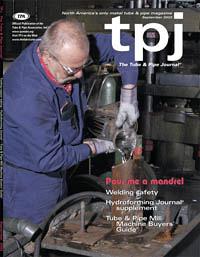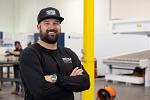President
- FMA
- The Fabricator
- FABTECH
- Canadian Metalworking
Categories
- Additive Manufacturing
- Aluminum Welding
- Arc Welding
- Assembly and Joining
- Automation and Robotics
- Bending and Forming
- Consumables
- Cutting and Weld Prep
- Electric Vehicles
- En Español
- Finishing
- Hydroforming
- Laser Cutting
- Laser Welding
- Machining
- Manufacturing Software
- Materials Handling
- Metals/Materials
- Oxyfuel Cutting
- Plasma Cutting
- Power Tools
- Punching and Other Holemaking
- Roll Forming
- Safety
- Sawing
- Shearing
- Shop Management
- Testing and Measuring
- Tube and Pipe Fabrication
- Tube and Pipe Production
- Waterjet Cutting
Industry Directory
Webcasts
Podcasts
FAB 40
Advertise
Subscribe
Account Login
Search
Plotting for success
Using edge thickness measurements to aid troubleshooting
- By W.B. "Bud" Graham
- October 23, 2003
- Article
- Tube and Pipe Production
Another way of looking at this is that we get so tied up in the day-to-day grind that we forget or ignore the deteriorating conditions in the forming mill and tooling until a customer complains about weld splits. We lose our edge, figuratively and literally, and it shows up in nonparallel edges and lousy welds. Roll shaft shoulder misalignment, roll tooling wear, poor changeover practices, and infrequent maintenance all contribute to the condition until things fall apart.
 |
| -Copyright 2003, all rights reserved, W.B. Graham. Process and investigation methodology are proprietary. Figure 1 Consistent and predictable changes in strip edge thickness distribution along the tube's length (pass to pass) and across its width (distance from skelp edge) indicate proper tooling setup. Strip width is 10.485 in.; thickness is 0.279 in.; the tube's finished diameter is 3.5 in. |
To succeed every day we need to attack the root causes of problems and not rely on the QC department. Solving problems isn't nearly as effective as preventing them, so we need to be as consistent as the butler, doing a little every day, staying on task to accomplish the goal.
Go Around Looking for Trouble
Inconsistent welds don't just happen by themselves. Specific problems cause them, and most of the causes are within your control. Changes in metallurgy can affect weld quality (someone got a bargain on a steel shipment from Timbuktu!), but materials should be specified to fit the application, not the other way around. Weld power supplies have advanced so much that modern units have self-diagnostic systems to alert the user to problems before they result in bad welds.
 |
| Figure 2 An isometric view of the data from Figure 1 shows that the strip edges are nearly identical to each other. Provided the mill operator maintains consistent edge height through the weld squeeze, the weld will be sound. |
Weld quality in high-frequency welded tube production is a direct reflection of edge presentation–when the edges are properly aligned and edge thickness is consistent, the resulting weld is sound.
This leaves the often-asked question: How can we judge our setup quality when operators say everything is OK but weld splits show up at odd times for no explainable reason? The answer is to pay attention to details and try to understand what really is happening in the strip forming process.
If the mill isn't turning out good product, mill operators tend to rely on their own experiences, perspectives, and opinions as to what the causes might be. The troubleshooting, therefore, can be driven more by personality than by knowledge. To remove personality factors from the situation, it's necessary to gather and analyze information. The key to preventing a single person from dominating the troubleshooting is to develop a team approach and involve everyone—operators, setup team, and maintenance crew—who has a hand in keeping the tube mill running.
We can look at roll tool gaps, diameter measuring tape readings, and material flow, but these measurements and observations provide only part of the answer. We need to get deeper into the analysis. An investigation of the weld fit-up condition can be reduced to simple numbers and a graphical representation. Using hard numbers, which eliminates personal opinions, goes a long way toward finding the actual root causes of failures.
 |
| Figure 3 An end view of the information portrayed in Figure 2 also shows consistent and, for the most part, gradual changes. |
Go Strictly by the Numbers
To rely on facts rather than personality traits, we need to determine what the facts are. Shut down the mill and, as a team, collect the necessary samples and perform the following measurements:
- Measure the full width and edge thickness of the parent strip before it passes through the entry table. Use this information to confirm that the slit width and thickness of the material are correct as it enters the mill.
- Collect complete open tube samples or samples cut from both sides of the skelp after each pass (from entry table through the last fin pass).
- Label the samples as to location (pass number or name) and orientation (drive or operator side).
- Cut all partially formed tube samples in half along the 6 o'clock line.
- Using a flexible ruler or template as a guide, mark each sample with a permanent marker at the following points from each edge: 0, 0.1, 0.250, 0.35, 0.5, and 1.00 inch. Determining the divisions is not as important as choosing an appropriate number of divisions and marking the locations consistently on each sample. On 0.250-in. and thicker material, three measurement locations usually are enough (0, 0.5, and 1 in.).
- Using a blade or point-type micrometer, record the thickness at each location.
- Enter the measurements into a table.
- Use a 3-D plotting program to represent the thickness distribution.
 |
| -Copyright 2003, all rights reserved, W.B. Graham. Process and investigation methodology are proprietary. Figure 4 Abrupt changes in strip edge thickness distribution from pass to pass near the strip edges in the fin passes indicate a poor mill setup. A table of rows and columns of data isn't the optimal troubleshooting tool, however, because such trends can be difficult to find in a table. For a graphic representation of the problems encountered in the fin passes, see Figures 5 and 6. Notes: * The arrows indicate where the skelp was forced offline by the roll tooling. * Strip dimensions and finished tube diameter are the same as those in Figure 1. |
The 3-D plotting program generates isometric and end views of the forming process. The plots show what the resulting skelp edges look like compared to one another. Although this information is identical to the information in the table, the images reveal changes in wall thickness that might not be as evident from looking at the rows and columns of numbers in the table.
The images don't represent the entire tubular profile, so they don't look like tubes. The resulting plots represent the opposing strip edges. The graphical representation allows us to see both the inside and outside of the joint fit-up. When the strip is progressing through the mill, we can observe only the OD and therefore we know only half of the story. Collecting hard data and plotting the results provide the missing information and help us determine why some welds go bad.
 |
| Figure 5 An isometric view of data from Figure 4 shows trouble in the fin passes and that one edge is notably thinner than the other. Compare to Figure 3. A photomicrograph of the resulting weld probably would indicate an edge alignment issue (one edge would be higher than the other edge after the OD scarfing step), but it really is a basic forming problem. |
Figure 1, Figure 2, and Figure 3 show data and plots that correspond to measurements taken from good tube formed and welded on a properly set up tube mill. The changes from pass to pass are gradual, and the two edges are nearly identical in thickness. Figure 4, Figure 5, and Figure 6 show data and plots that correspond to measurements taken from substandard tube formed and welded on an improperly set up tube mill. The changes from pass to pass are reasonably consistent in passes 0 to 4, but abrupt changes occur in the fin passes. In addition, the two edges are not identical to each other in the fin passes and at the weld point. These are visual clues that relate to deformation in the skelp edge and the resulting thinning that took place.
What's the cause of the abrupt changes in material thickness? The material has been slammed back and forth through the fin passes, and the result is that one edge is not cold-worked to the same extent as the other edge. This indicates roll shaft shoulder misalignment or improper roll spacer installation. It takes a surprisingly small misalignment to create this picture.
When this condition is coupled with other problems, such as varying slit width (strip that varies from being the correct width to being too narrow) or yield strength that is higher than that specified for the roll tooling, the results are variable edge presentation and mysterious weld defects that seem to come and go at will.
Collect Good and Bad Samples
 |
| Figure 6 An end view of the data from Figure 4 shows that passes 0 through 4 are acceptable, but that the fin passes are not. Compare to Figure 3. The tables and plots (Figures 1 through 6) don't tell what caused the problem, but they do tell the tube mill crew where the problem started and therefore where to begin troubleshooting. |
Remove the black art, collect the necessary physical evidence, and review the resulting visual clues. The team now has another tool that is not personality-driven and therefore factual. The time spent in the exercise will pay off in an improved understanding of the tube forming process, enhanced teamwork, and better weld quality.
The process should be carried out several times so the team has a reliable sample size for making valid comparisons. Good and bad production runs should be documented. This methodology is suitable for all but the thinnest-wall tube production.
Plot for success and you'll find that the real story is far better than any novel.
If you have a specific question or would like to see an article on a particular problem, please contact the author or TPJ.
About the Author
W.B. "Bud" Graham
P.O. Box 202
Doylestown, OH 44230
330-408-3447
About the Publication
Related Companies
subscribe now

The Tube and Pipe Journal became the first magazine dedicated to serving the metal tube and pipe industry in 1990. Today, it remains the only North American publication devoted to this industry, and it has become the most trusted source of information for tube and pipe professionals.
start your free subscription- Stay connected from anywhere

Easily access valuable industry resources now with full access to the digital edition of The Fabricator.

Easily access valuable industry resources now with full access to the digital edition of The Welder.

Easily access valuable industry resources now with full access to the digital edition of The Tube and Pipe Journal.
- Podcasting
- Podcast:
- The Fabricator Podcast
- Published:
- 04/16/2024
- Running Time:
- 63:29
In this episode of The Fabricator Podcast, Caleb Chamberlain, co-founder and CEO of OSH Cut, discusses his company’s...
- Industry Events
16th Annual Safety Conference
- April 30 - May 1, 2024
- Elgin,
Pipe and Tube Conference
- May 21 - 22, 2024
- Omaha, NE
World-Class Roll Forming Workshop
- June 5 - 6, 2024
- Louisville, KY
Advanced Laser Application Workshop
- June 25 - 27, 2024
- Novi, MI































